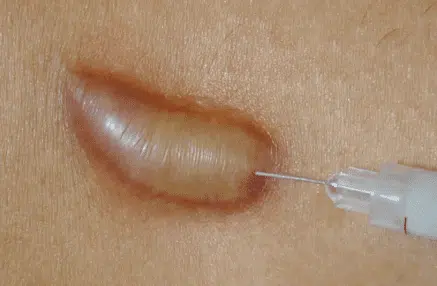Keloids and keloid scars are notoriously hard to get rid off. There are no known effective home remedies to treat keloids hence, the best method is prevention of keloid formation. There are certain home remedies you can follow to prevent the formation of keloids or to reduce their appearance once they have formed. The home remedies are:
Silicone gel : it has been proven to remove keloid and its scarring in certain cases. They induce shrinking of the keloid and also prevent it from recurring.The advantage is that silicone gel has minimal side effects and is easy to use.
Heavy skin cream : skin creams containing petrolatum may improve keloid scar appearance. Using the cream regularly covers the injured skin while it heals and prevents keloids formation. Creams that contain vitamin E or onion extract which are said to be beneficial in wound healing has shown no effect in keloid treatment.
The medical treatment for keloids are :
– Corticosteroid injections : these injections are given directly into the lesion once every 4 to 8 weeks. It helps reduce the protrusion of the keloid hence giving it a flat appearance. Unfortunately, once these keloids are flatten they appear redder as the corticosteroids stimulates vascular growth in the keloids. These injections may be painful but they are safe. The best result it can provide is a flat skin surface but with a mark that appears and feels different from the surrounding skin.
– Pressure earrings : Specially designed earrings are available to reduce the keloid scar on the earlobe significantly when used.
– Interferons : Interferons are the body’s defense mechanism against viruses, bacteria and other pathogens. Injections of interferon have been proven to reduce the size of the keloids though it is uncertain whether the effects are temporary or permanent. There is also a method of applying topical imiquimod which then stimulates interferon production in the body.
– Chemotherapy : In some cases, injections of fluorouracil and bleomycin have been used a form of treatment for keloid scars.
– Radiation : Some doctors use radiation therapy on the keloid to cause it to shrink and prevent its recurrence.
– Cryotherapy : Using liquid nitrogen to freeze the keloids might treat it but it causes a pigmentation problem post freezing. The scar either becomes darker or lighter in certain people.
There are few surgical procedures which can be used to treat keloid formation :
– Surgery : Is it said that cutting a keloid will trigger it to grow and expand further, but some surgeons have managed to obtain success by excising the keloid then applying pressure compression and intralesional corticosteroid injections over the next few months. Some surgeons also use concurrent radiation therapy post surgery to prevent recurrence of the keloids.
– Laser : Pulsed dye lasers are the laser of choice for keloid treatment. It flattens the keloids and reduces its vascular growth beneath the skin hence lightening its appearance. This method is safe but it requires few sessions and the other advantage is that this procedure is not painful.
What are the possible risks and complications?
There are associated risks to every procedure. In the case of keloid treatment, the highest and most recurring risk factor is the recurrence of the keloid post treatment. There is risk of the keloid doubling up in size during the recurrence. The other risks are that keloid formation post burns on the chest of neck areas can lead to strictures and breathing difficulties, such cases require immediate intervention. Keloids when present at the joints can lead to a mobility issue and restriction. The chances of keloids turning cancerous is minimal.
It is always best to avoid unnecessary injury to skin if you are aware of keloid history in the family. Keloids are mostly mentally and emotionally damaging as they disfigure a person’s appearance affecting their self confidence.
















